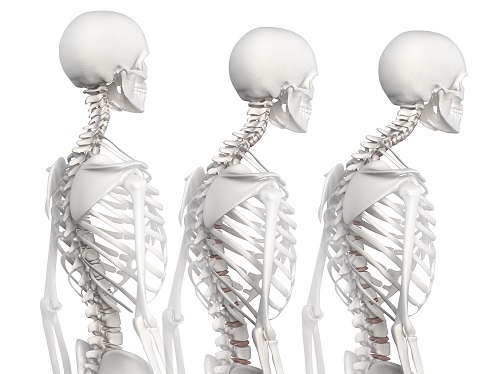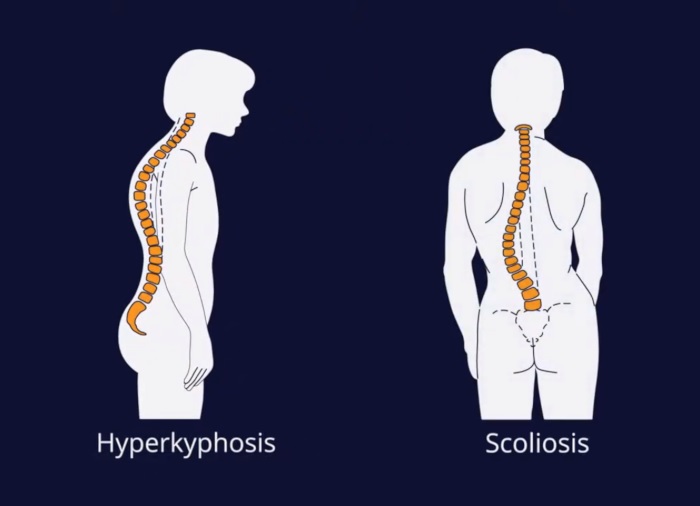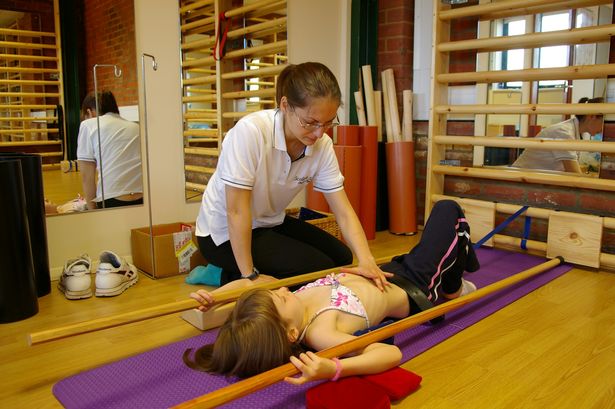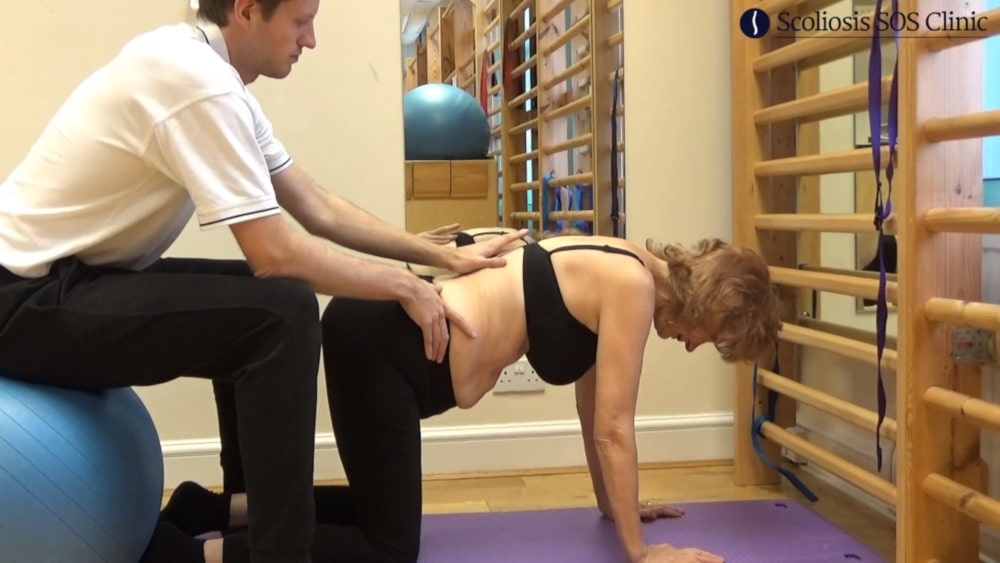
Hyperkyphosis (often just called kyphosis) is a curvature of the spine that occurs in the upper back, resulting in a hunched or stooped appearance.
It affects approximately 8% of the general population, and while it is most common in older people, it can affect men and women of all ages.
Watch our video to learn everything you need to know about hyperkyphosis:
Kyphosis is sometimes known as ‘dowager’s hump‘, particularly if the patient is getting on in years. ‘Hunchback’ is a somewhat derogatory term for a person with kyphosis.
Hyperkyphosis vs Scoliosis: What’s the Difference?
Hyperkyphosis and scoliosis are two different curvatures of the spine.
We treat both conditions here at the Scoliosis SOS Clinic, and they can occur together (see kyphoscoliosis). But they’re not the same thing.

The difference lies in the direction of the curvature:
- Hyperkyphosis: Causes the upper* region of the spine to curve forwards, making the patient’s upper back look unusually rounded or hunched.
- Scoliosis: Causes the spine to curve sideways, forming a ‘C’ or ‘S’ shape.
*Excessive forward curvature of the lower spine is known as hyperlordosis. Read our Curvatures of the Spine guide for more information.
How Does Hyperkyphosis Affect the Body?
Kyphosis patients can usually be recognised by their visibly hunched backs, but this is just one of the many ways in which hyperkyphosis can affect one’s body.

Other symptoms of kyphosis include:
- Back pain
- Stiffness and discomfort
- Reduced mobility / flexibility
- Fatigue
- Poor body image
But that’s not all. A severe kyphotic spinal curve can even interfere with the body’s most fundamental inner workings, such as the respiratory and digestive systems.
> How does hyperkyphosis affect breathing?
If hyperkyphosis is not treated and the spinal curve continues to get worse over time, there is a risk that it may eventually begin to adversely affect the patient’s ability to breathe. This happens because especially severe spinal deformities inevitably end up warping other parts of the skeleton, including the rib cage; this leaves the lungs with less room to inflate, resulting in compromised breathing.
> How does hyperkyphosis affect the digestive system?
Severe hyperkyphosis can also impact on the patient’s ability to digest food normally. Again, this is due to the knock-on effect that a pronounced spinal curve can have on other parts of the body. In the case of the digestive system, problems may arise because the patient’s internal organs are being squashed together, potentially obstructing the passage of food through the intestines. Acid reflux is also fairly common among people with advanced hyperkyphosis.
> How does hyperkyphosis affect the nervous system?
In some cases, the distortion of the body due to hyperkyphosis can end up impinging on a nerve. Depending on where in the body this happens, nerve compression can lead to:
- Persistent aches/pains
- Numbness or tingling sensations
- Certain body parts feeling weak
- Loss of bladder/bowel control
The good news is that all of these consequences are relatively rare and do not arise in the majority of mild to moderate cases of hyperkyphosis.
What Causes Hyperkyphosis?
Kyphosis can develop for a number of different reasons, and some forms of this condition are more preventable than others.
Here are some of the most common causes of hyperkyphosis (and who they’re most likely to affect):
- Bad Posture – If you persistently slouch forward or lean back when seated, you may notice that your spine starts to develop a visible curvature over time. Desk workers are particularly prone to the sort of postural problems that can lead to hyperkyphosis.
- Scheuermann’s Disease – Scheuermann’s disease typically occurs during the growth spurt that accompanies puberty. If you have this condition, it means that your vertebrae (the bones that make up your spine) develop into a wedge shape, creating a forward spinal curve. Learn more about Scheuermann’s disease here.
- Congenital Issues – While rare, it is sometimes the case that a baby’s spine will develop incorrectly in the womb, and this can mean that hyperkyphosis is present from birth. This is called congenital kyphosis, and when it does occur, it usually begins within the first 6-8 weeks of embyronic development.
- Osteoporosis – Human beings (especially women) often lose bone density as they get older, a condition known as osteoporosis. The resulting bone weakness can lead to a range of different problems, including curvature of the spine. Learn more about osteoporosis here.
- Spinal Injury – Certain accidents and injuries can impact the spine, resulting in hyperkyphosis in some cases.
How to Prevent Hyperkyphosis
While hyperkyphosis can be treated, it is often impossible to prevent it from developing altogether.
Scheuermann’s kyphosis and congenital kyphosis cannot be prevented with lifestyle changes. Good posture will reduce your risk of developing postural kyphosis, and a healthy diet and weight-bearing exercises can help to prevent kyphosis from developing as a result of osteoporosis.
If you want to prevent hyperkyphosis, here’s what we recommend:
- Avoid rounding your shoulders and make an effort to observe your posture when sitting, walking or standing.
- Perform exercises which increase bone mass – rebounding on a trampoline is very effective for this, and is even used by astronauts preparing for space travel.
- Eat a diet rich in Calcium and Vitamin D, such as spinach, fatty fish and fortified foods.
- Perform exercises to improve your posture at home, especially if you work in a job that requires you to sit for long periods of time or lift heavy objects. Here are some exercises to get you started.
- Seek physical therapy from a qualified professional who will be able to identify the cause of your poor posture.
Hyperkyphosis Treatment
As with scoliosis, there are a number of different hyperkyphosis treatment methods in use, including both surgical and non-surgical options.

The most prevalent treatment methods are:
- Bracing – During adolescence, bracing may be required to stunt the progression of the patient’s kyphosis in moderate to severe cases. Bracing aims to ensure that the degree of the curvature does not develop any further than it already has. The patient may be required to continue wearing the brace until their spine stops growing at around 16 years of age. Learn more about how a hyperkyphosis brace works here.
- Pain Management – As is the case for many health problems, pain management is often a central part of hyperkyphosis treatment. Painkillers such as ibuprofen or paracetamol can help to relieve the aches and pains that derive from having a curvature of the spine. If the patient is in a lot of pain, stronger pain relief medications may be prescribed.
- Physical Therapy – Though it does require some work on the patient’s part, physiotherapy is a great way to treat hyperkyphosis. Physical therapy programmes such as our own ScolioGold method can straighten the back, reduce pain, and improve the patient’s quality of life in general – see before and after photos here.
- Surgery – If the curvature becomes so severe that the patient is having difficulty going about their day, surgery may be recommended. Spinal fusion is the standard surgical procedure for hyperkyphosis – this involves fusing the vertebrae together to correct the spine’s curvature. Method rods, screws, hooks and bone grafts are used during the operation to fuse the bones together. The operation takes 4-8 hours, and a back brace may need to be worn for up to 9 months while your spine heals.
Matthew from Exeter: A Kyphosis Case Study
Matthew Ellison came to the Scoliosis SOS Clinic in 2018. Our treatment course helped to reduce his back pain, and he actually grew by 3.8cm during his time here!
Read Matthew’s story in full here. Matthew is just one of the many hyperkyphosis patients we’ve helped – if you’d like to find out more about our physical therapy courses, please give us a call on 0207 488 4428.
Learn Some Hyperkyphosis Exercises Book Your Initial Consultation
Susanne Henderson (a 69-year-old woman from Totnes, Devon) contacted the Scoliosis SOS Clinic in the hope that we’d be able to treat her hyperkyphosis. Read on to hear her story and how we were able to help her and reduce her spinal curve!

Susanne, unlike the majority of patients we treat here at the Scoliosis SOS Clinic, doesn’t have scoliosis. Rather, she has a condition known as hyperkyphosis, characterised by an excessive forward curvature of the thoracic (upper) spine.
Susanne was diagnosed with hyperkyphosis following a series of accidents that gave her back a rounded shape and left her experiencing mild to moderate pain in her spine. When the medical professionals Susanne consulted didn’t take her worries seriously enough, she decided to take it upon herself to find the treatment she needed.
Susanne contacted the Scoliosis SOS Clinic to enquire about our ScolioGold treatment programme. Although the corrective course is quite intensive, Susanne says that she has “coped very well”, and that she appreciated being allowed to perform exercises at her own pace while still being pushed. When asked what she would say to other individuals with hyperkyphosis, Susanne recommended: “start taking action yourself and treat it before it gets worse”.
As a result of the corrective exercises we have prescribed for Susanne, she says she’s started to feel more “liberated, empowered and confident”, and she is confident that she can carry on improving now that her ScolioGold course has come to an end.
To see a full account of Susanne’s story, watch the video below:
If you have any questions about the Scoliosis SOS Clinic, or if you would like to book an initial consultation with us, please get in touch today!
Contact Us >
In November 2018, the Scoliosis SOS Clinic helped treat Matthew Ellison, a 31-year-old male from Devon who was diagnosed with hyperkyphosis and hyperlordosis following an injury. Here is his story!

As Matthew explained to us, he had always noticed that his back had a rounded shape, particularly in the shoulder and thoracic region. During Matthew’s early teenage years, his mother took him to the doctor to have his back looked at, and the doctor informed him that he would simply grow out of it.
As the years went by, however, Matthew saw that he hadn’t grown out of it, and in his mid-to-late 20s he started to experience increased levels of discomfort and pain on a daily basis – and especially during sports participation. Things got worse for Matthew when he suffered an injury, which resulted in an X-ray scan and a recommendation for spinal fusion surgery. This was something that Matthew was not keen on at all and wanted to avoid, and so his doctor suggested that he could try a non-surgical treatment programme like the Schroth method. Matthew conducted some of his own research, and this eventually led him to the Scoliosis SOS Clinic.
Before reaching out to us, however, Matthew attempted to self-medicate his back problem with regular physical exercise in an effort to ‘open up’ the curve in his spine and strengthen his upper back muscles. Unfortunately, due to the injury that he had suffered, these exercises ended up making his spine worse. Matthew then sought professional help and undertook a 12-week physiotherapy course in the hope of correcting his spinal curvature; during this time, he was given simple instructions which helped with pain relief at the end of each day, but weren’t enough to reduce the curve.
Matthew comes to the Scoliosis SOS Clinic
Matthew found the Scoliosis SOS Clinic’s website via Google and decided to get in touch. After a simple phone call that answered a lot of Matthew’s questions, he decided to undertake a 4-week ScolioGold course with us to help alleviate the problems that he was experiencing. Matthew was sceptical at first regarding the efficacy of group-based therapy, but was very impressed with the level of attention he received during his one-on-one sessions. The treatment that we provided comprised massage for pain relief and specific exercises that targeted the affected area of Matthew’s spine.
Upon the conclusion of his treatment course, Matthew’s hyperkyphosis and hyperlordosis had returned to within normal range. Not only was he no longer in pain, he had actually grown 3.8cm taller!
Matthew recommends the Scoliosis SOS Clinic to anyone experiencing back problems like his. Watch the video below for a full account of Matthew’s story and to see how the Scoliosis SOS team were able to help him.
If you have any questions about the Scoliosis SOS Clinic, or if you would like to book an initial consultation with us, please get in touch today!
Contact Us >
